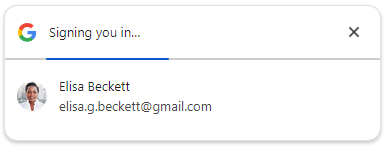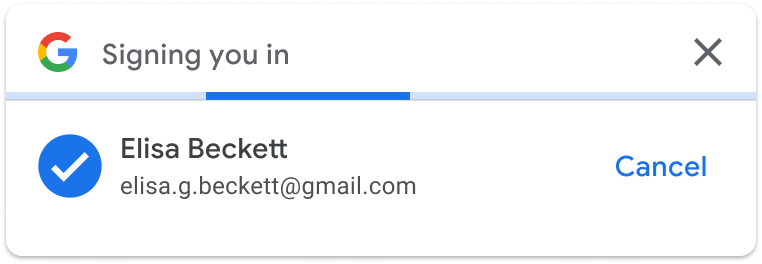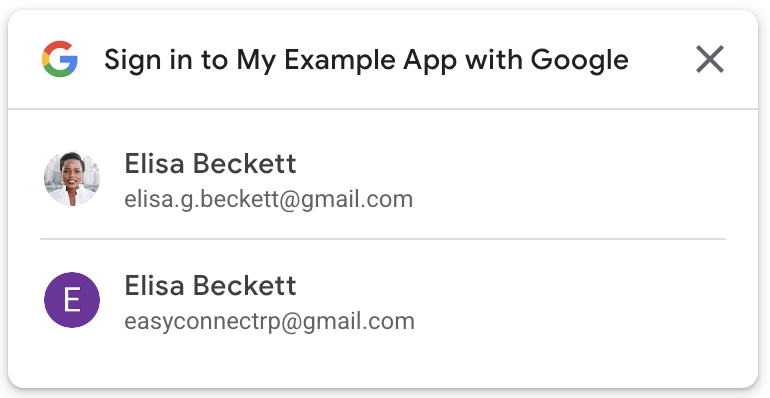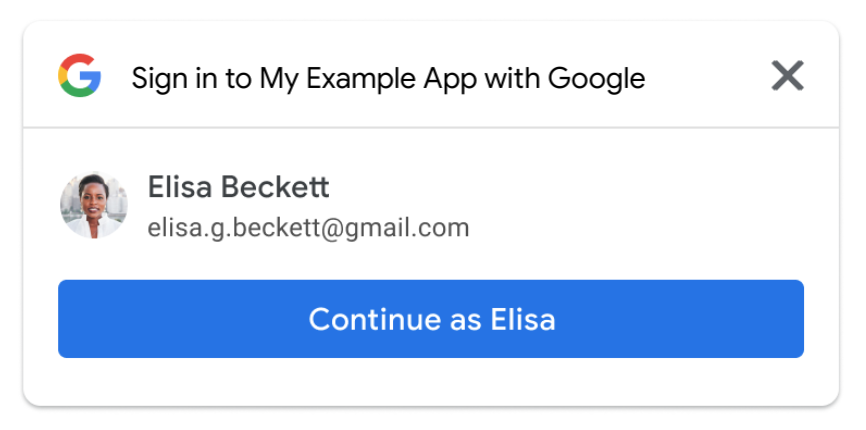이 페이지에서는 사용자가 Google One Tap으로 로그인하거나 로그아웃하는 방법과 관련된 기능을 구현하는 방법을 설명합니다.
사용자 자동 로그인
Google One Tap은 자동 로그인을 지원합니다. 자동 로그인은 사용자가 사이트로 돌아올 때 취해야 하는 수동 단계를 없애 원활한 사용자 환경 (UX)을 제공합니다. 사용자는 마지막 방문 시 선택한 Google 계정을 기억할 필요가 없으므로 플랫폼에서 불필요한 중복 계정이 생성될 가능성이 줄어듭니다.
자동 로그인은 Google 계정으로 로그인 버튼과 원탭 대화상자를 보완하기 위한 것입니다. 이 API는 사용자가 사이트에서 처음 로그아웃한 후에만 수동으로 가입하거나 계정을 전환할 수 있도록 사이트 전체에서 사용할 수 있도록 설계되었습니다.
자동 로그인이 이루어지려면 다음 조건이 필요합니다.
- 사용자는 먼저 Google 계정에 로그인해야 합니다.
- 이전에 앱과 계정 프로필을 공유하는 데 동의한 적이 있으며,
- FedCM을 사용하는 경우 지난 10분 동안 로그인 시도를 한 번만 시도했습니다. 이 기간 동안 로그인 시도가 반복되면 원탭이 표시됩니다.
- FedCM을 사용하면 사용자가 FedCM 출시 전에 웹사이트를 승인했더라도 각 Chrome 인스턴스에서 Google 계정으로 웹사이트에 로그인할 것인지 다시 확인해야 합니다. 이 변경사항은 원탭을 사용하는 기존 사이트의 전환율에 영향을 줄 수 있습니다. Chrome M121 업데이트에서 자동 로그인 개선으로 전환율 하락 문제가 완화되었습니다.
자동 로그인이 사용 설정된 페이지에서 이러한 조건이 충족되면 사용자 상호작용 없이 사용자의 ID 토큰 사용자 인증 정보가 자동으로 반환됩니다. 이러한 조건이 충족되지 않고 페이지에서 자동 로그인이 사용 설정되어 있더라도 사용자는 기본적으로 로그인 또는 동의에 대해 원탭 흐름을 사용합니다. 사용자에게 Google 계정이 여러 개 있고 사이트를 방문하는 경우 먼저 하나의 Google 계정에 로그인하고 해당 계정에 동의해야 합니다.
반환된 사용자 인증 정보 객체의 select_by 필드에 있는 auto 값을 사용하여 자동 로그인 성공률을 측정할 수 있습니다.
자동 로그인을 사용 설정하려면 다음 스니펫과 같이 코드에 data-auto_select="true"를 추가합니다.
<div id="g_id_onload"
data-client_id="YOUR_GOOGLE_CLIENT_ID"
data-login_uri="https://your.domain/your_login_endpoint"
data-auto_select="true">
</div>
로그아웃
사용자가 웹사이트에서 로그아웃하면 Google One Tap 메시지가 자동으로 표시되는 페이지로 연결될 수 있습니다. 이 설정의 경우 자동 선택을 금지해야 합니다. 그렇지 않으면 사용자가 자동으로 다시 로그인되어 데드 루프 UX가 발생합니다.
FedCM 사용
사용자 환경을 개선하기 위해 자동 로그인 시도 간에 10분의 비활성 시간이 있습니다. 이 기간에는 원탭 메시지가 대신 표시됩니다. 사용자는 원탭을 명시적으로 클릭하여 로그인해야 합니다.
FedCM 미사용
사용자가 로그아웃한 후 자동 선택을 금지하려면 모든 로그아웃 링크와 버튼에 클래스 이름 g_id_signout를 추가합니다. 다음 코드 스니펫을 참고하세요.
<div class="g_id_signout">Sign Out</div>
다음 JavaScript 코드 스니펫을 로그아웃에도 사용할 수 있습니다.
const button = document.getElementById('signout_button');
button.onclick = () => {
google.accounts.id.disableAutoSelect();
}
데드 루프 UX를 방지하기 위해 사용자 로그아웃 상태는 Google ID 서비스 라이브러리에서 설정하는 g_state라는 쿠키에 저장됩니다. 기본적으로 쿠키 도메인은 현재 페이지의 도메인으로 설정됩니다. 상위 도메인 및 하위 도메인에 원탭이 표시되는 경우 상태 쿠키가 모든 도메인에 표시되어야 합니다. data-state_cookie_domain 속성을 사용하여 g_state 쿠키 도메인을 상위 도메인으로 설정합니다. 예를 들어 example.com의 상위 도메인과 webapp.example.com라는 하위 도메인의 g_id_onload 요소에 data-state_cookie_domain="example.com"를 추가합니다.
도메인에서 사용되는 모든 쿠키를 모니터링하는 서비스가 있는 경우 g_state 쿠키를 알려야 합니다.
로그인 후 페이지에 클라이언트 라이브러리를 로드하지 않으려면 다음 솔루션을 사용하여 로그아웃 후 데드 루프 UX를 방지하세요.
- 로그아웃 시 사용자를 원탭이 표시되지 않거나 자동 로그인이 항상 사용 중지된 페이지 (예:
https://example.com/logged_out)로 리디렉션합니다. - 로그아웃 시 URL에 매개변수를 추가합니다. 예를 들면
logged_out=1입니다. JavaScript API로 원탭을 렌더링할 때 URL 매개변수를 확인하고 자동 로그인이 있는 경우 사용 중지합니다.
주요 사용자 경험
자동 로그인 페이지
FedCM 사용

사용자는 X 버튼을 클릭하여 원탭 메시지를 닫을 수 있습니다. 접근성 고려를 위해 사용자가 X 버튼을 클릭하더라도 ID 토큰은 웹사이트와 공유됩니다.
사용자 환경을 개선하기 위해 자동 로그인 시도 간에 10분의 비활성 시간이 있습니다. 이 기간에는 원탭 메시지가 대신 표시됩니다. 사용자는 원탭을 명시적으로 클릭하여 로그인해야 합니다.
FedCM 미사용

사용자가 5초 이내에 취소 버튼을 클릭하지 않으면 ID 토큰이 웹사이트와 공유됩니다.
로그인이 취소되면 활성 Google 세션 수에 따라 계정 선택기 페이지 또는 재방문자 페이지가 표시됩니다.
- 여러 Google 세션

- 단일 Google 세션

